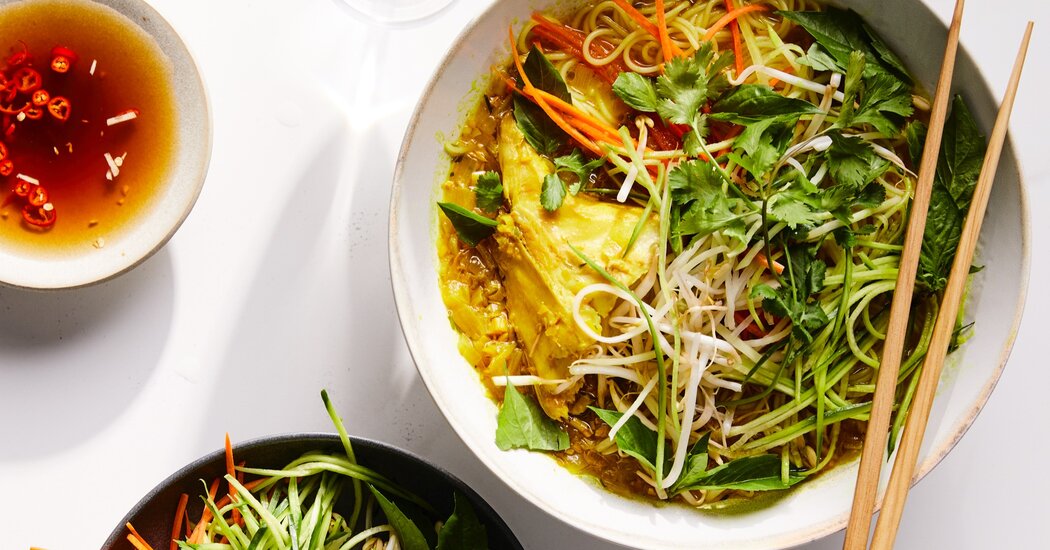Put it in pasta, stews or this thick, creamy coconut curry from Vietnam.
If you have some very fresh anchovies, a heap of salt and a roomy barrel to ferment it all in, you technically have everything you need to make fish sauce. But it takes skill to get to a delicious, uncut first press, a glowy amber ripple of salt, so mellow you can taste it neat, so lavish with umami you feel a warm rush to the head.
Cuong Pham learned this very quickly when he started making fish sauce on the Vietnamese island Phu Quoc, just south of Cambodia, where the weather is hot and humid, ideal for long, fishy fermentations, and the waters going out the Gulf of Thailand shimmer with wild black anchovies. The tiny fish, low on the food chain, are absolutely packed with glutamates, the protein that can give finished sauces their precious, lip-smacking depth.
Pham’s barrel house now holds 190 barrels, each one containing about 14 tons of anchovies. But in “The Red Boat Fish Sauce Cookbook,” written with Tien Nguyen and Diep Tran, he explains that it took three years of tinkering to get it right, and to make a sauce that would have met the approval of his mother, Cai Thi Kim Van. She was an extraordinary and versatile cook who kept handwritten notebooks filled with recipes that reflect her own Vietnamese background as well as her formal French training and her interests in other cuisines. Pham’s cookbook doesn’t quite replicate these family recipes but lovingly interprets them. His mother’s ga quay, or roast chicken, wasn’t roasted at all, as most home cooks then didn’t have ovens. Cai achieved the texture by steaming it, then pouring smoking hot oil all over to get a crackle on the skin. In the book, the chicken is seasoned with fish sauce, soy sauce and bay leaves, then spatchcocked and roasted in an oven — no hot-oil drizzle.
She could still smell the grassiness of cilantro root, the softly medicinal qualities of the turmeric, the perfumes of makrut and lemongrass.
The recipes are rarely stringent — if you can’t find hot mint, you can’t find hot mint! — and encourage adaptation and variation. Collected, they also trace the shift of fish sauce from Vietnamese kitchens into more American restaurant kitchens and home kitchens of all backgrounds over the last decade, particularly on the West Coast, and present it as a kind of borderless, fluid ingredient. This makes sense if you’re selling fish sauce, obviously, but it also makes sense if you’re cooking with it. The butterflied grilled perch recipe is inspired by the chef Sergio Peñuelas, from Nayarit, in Mexico, and his pescado zarandeado. The whole fish is marinated in butter, fish sauce and turmeric, then served with caramelized onions and corn tortillas. The dish makes perfect sense, and so does using fish sauce in a Caesar salad dressing, instead of (or as well as) tinned anchovies. As Pham points out, a splash of fish sauce in pasta, stews and many other European dishes has long been part of the Vietnamese cook’s approach, including his mother’s.
The book also includes a recipe for bun ken, a saucy coconut fish curry with rice noodles and plenty of raw, crunchy toppings — a street food specialty of Kien Giang Province, often served by vendors on Phu Quoc starting first thing in the morning. It wasn’t meant to go in the book, but the chef Diep Tran, while researching the book with Pham and Nguyen on the island, tasted it one day for breakfast and became preoccupied with it, and recreating it. “It was the first thing I did when I got home,” Tran said. “I thought, I have to do this while my memory is still good.”
The noodles were fine and rice. And she’d seen dimples of red oil, which indicated annatto. And she could still smell the grassiness of cilantro root, the softly medicinal qualities of the turmeric, the perfumes of makrut and lemongrass. The recipe walks you through that precisely layered curry: thick and creamy, deeply flavored with the browned aromatics and steeped coconut milk, all built on a base of fish broth. But it isn’t complete without the nuoc cham, which is used not as a dipping sauce here but as a dressing for green papaya, cucumber, carrots and the load of herbs and sprouts that you pile on top of each bowl.
In the spirit of the book, Tran adapted a bit, calling for fatty yellowtail collars instead of whole fish, to make pulling the meat a little more efficient for home cooks.
Recipe: Bún Kèn (Coconut Fish With Noodles)


























